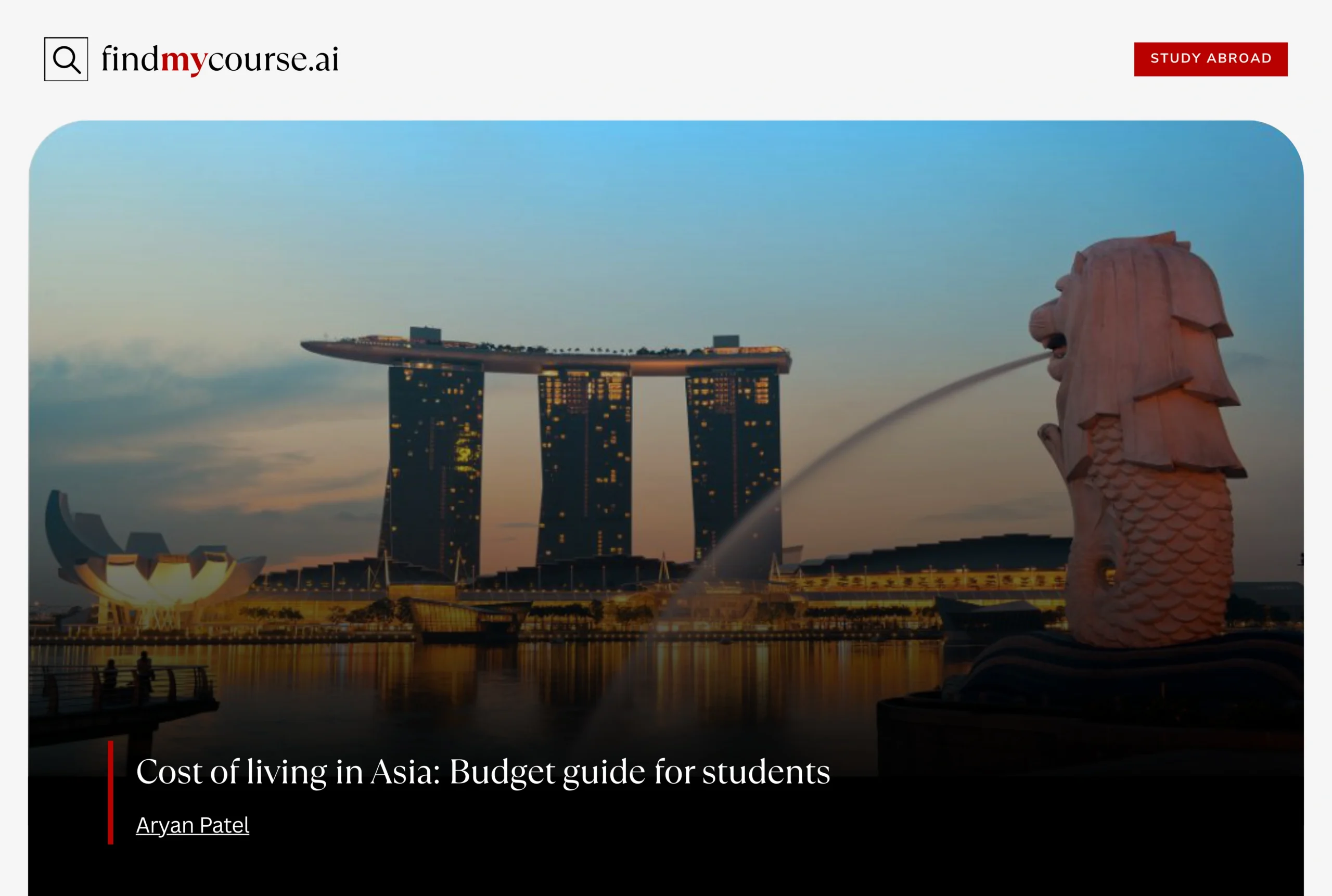If you’re planning to study abroad, Asia is a smart and exciting choice. From world-class universities to culturally rich cities, the continent offers plenty of advantages. But here’s the real deal: understanding the cost of living in Asia is just as crucial as choosing the right course. Let’s walk through what it really means to live and study in countries like Singapore, Mauritius, and Malaysia. These destinations not only provide top-notch academic opportunities but also a diverse lifestyle that caters to students. Whether you’re into city life or island vibes, knowing your budget will help you enjoy every moment without financial stress.
Why Asia is a Smart Study Destination
It’s no secret that Asia is growing in popularity among international students. Not only do you get high-quality education, but the cost of living in Asia is often more affordable than in the US or Europe. Countries like Singapore are known for academic excellence, while places like Malaysia and Mauritius deliver great education at budget-friendly prices.
Besides the financial appeal, students benefit from diverse cultures, modern cities, and plenty of travel opportunities. Whether you’re drawn to the tech-savvy vibes of Singapore or the island charm of Mauritius, there’s something for everyone. From bustling street markets to serene beaches, Asia promises a rich student life that blends learning with unforgettable experiences.
Tuition Fees: Know the Numbers First
Tuition is usually the biggest part of your academic expenses. In Singapore, for instance, fees can be steep, ranging from SGD 16,000 to SGD 120,000 per year. That reflects the world-class education offered by institutions like NUS.
Malaysia, in contrast, provides more affordable degrees. Expect to pay MYR 25,000 to MYR 73,000 annually. Over in Mauritius, fees generally range from USD 1,500 to USD 7,000, making it a cost-effective option.
Want to cut these costs? Scholarships are widely available. Look into the ASEAN scholarships for Singapore or international grants from Malaysian universities to reduce the overall cost of living in Asia.
What Makes Up the Cost of Living in Asia?
Living abroad comes with various expenses beyond tuition. Here’s a closer look at major cost areas: housing, food, transportation, utilities, and leisure. These categories directly influence the total cost of living in Asia.
Housing: Where You Live Matters
Accommodation is a significant slice of your monthly budget. Prices vary widely depending on your chosen country and city.
| Country | On-Campus Dorms | Shared Apartments | Notes |
| Singapore | SGD 140–SGD 440 | SGD 265–SGD 1,000 | Little India offers cheaper rents for Indian students. |
| Mauritius | USD 100–USD 300 | USD 200–USD 500 | Affordable in areas like Curepipe; pricier in Port Louis. |
| Malaysia | MYR 200–MYR 600 | MYR 300–MYR 1,600 | Kuala Lumpur is costly; Penang is more affordable. |
For a lower cost of living in Asia, consider shared accommodations or student dormitories. Places like Penang (Malaysia) and Curepipe (Mauritius) offer budget-friendly options.
Food & Groceries: Eating on a Student Budget
Food costs can sneak up on you if you’re not careful. But the good news? Asia offers lots of affordable dining options.
| Country | Monthly Groceries | Meal at Hawker Stall | Notes |
| Singapore | SGD 300–SGD 600 | SGD 3–SGD 7 | Hawker centers like Maxwell offer cheap, tasty meals. |
| Mauritius | USD 100–USD 200 | USD 2–USD 5 | Local markets in Flacq provide affordable produce. |
| Malaysia | MYR 200–MYR 400 | MYR 5–MYR 15 | Jalan Alor in Kuala Lumpur has budget-friendly street food. |
To reduce your cost of living in Asia, cook meals with roommates or buy in bulk from local markets. Street food is also both tasty and budget-friendly.
Transportation: Student-Friendly Travel
Getting around in Asia is pretty convenient. Public transport is well-developed in most student hubs, and student passes offer great discounts.
| Country | Monthly Transport Pass | Notes |
| Singapore | SGD 45–SGD 52 | Concessional student fares on MRT and buses. |
| Mauritius | USD 20–USD 50 | Buses are cheap; taxis cost USD 1–USD 2 per km. |
| Malaysia | MYR 50–MYR 150 | GoKL buses in Kuala Lumpur are free for students. |
Malaysia even offers free buses in cities like Kuala Lumpur for students. These options make it easier to maintain a low cost of living in Asia.
Utilities and Internet: Budgeting for Basics
Essential services like electricity, water, and the internet also play into the overall cost of living in Asia.
| Country | Utilities | Internet | Notes |
| Singapore | SGD 100–SGD 200 | SGD 30–SGD 60 | High-speed internet is reliable but costly. |
| Mauritius | USD 50–USD 150 | USD 20–USD 40 | Air conditioning increases bills in summer. |
| Malaysia | MYR 100–MYR 250 | MYR 30–MYR 60 | Prepaid plans from Digi or Maxis are affordable. |
Pro tip: share internet plans and limit air conditioning use to keep your costs down.
Monthly Snapshot: How It All Adds Up
Here’s a quick view of total monthly living costs (excluding tuition):
| Country | Total Monthly Expenses | Notes |
| Singapore | SGD 900–SGD 2,560 | High costs, premium lifestyle. |
| Mauritius | USD 400–USD 1,000 | Affordable, tropical vibe. |
| Malaysia | MYR 1,200–MYR 2,500 | Budget-friendly, cultural richness. |
Budgeting Tips That Actually Work
Managing your finances while studying abroad doesn’t have to be stressful. Here are a few tips:
- Use Budgeting Apps: Tools like Wallet or Money Lover can help track your daily expenses, ensuring you stay within your budget.
- Work Part-Time: In Singapore and Malaysia, international students can work up to 20 hours per week, earning extra income to offset the cost of living in Asia. Mauritius may have stricter rules, so always check visa regulations.
- Live Smart: Choose student housing and share groceries to save big on rent and food costs.
- Use Discounts: Get an ISIC card to unlock transport, entertainment, and dining deals across Asia.
- Plan Meals: Cooking at home can reduce food expenses by 30%, freeing up funds for other essentials.
- Seek Scholarships: Reducing tuition costs through grants like Singapore’s ASEAN Scholarships or Malaysia’s CSFP helps manage the full cost of living in Asia.
- Shop Wisely: Buy from local markets or discount stores to cut grocery bills significantly.
- Limit Impulse Buys: Stick to a shopping list to avoid unnecessary spending and stretch your budget further.
Why Understanding Costs is So Important
Knowing the cost of living in Asia gives you a massive advantage. It allows you to plan ahead, reduce stress, and enjoy your international journey fully. From bustling cities like Singapore to the peaceful vibe of Mauritius, Asia offers options for every lifestyle and budget. By understanding expenses like housing, food, and transport, you can make informed choices that align with your financial goals. Whether you’re drawn to Malaysia’s affordability or Singapore’s vibrant urban scene, budgeting smartly ensures you maximize your study abroad experience while keeping the cost of living in Asia manageable, letting you focus on academics and cultural adventures.
Final Thoughts: Study Smart, Spend Wisely
The cost of living in Asia is manageable with the right planning. Singapore may be on the pricier side, but its world-class amenities can be worth it. Malaysia and Mauritius, on the other hand, offer lower costs and a great student life.
So if you’re serious about balancing academics with affordability, get ahead by understanding your finances. Start budgeting now, and you’ll enjoy every moment of your educational adventure in Asia. By researching expenses like housing, food, and transport, you can stretch your budget further. Leverage student discounts, cook at home, and explore scholarships to keep the cost of living in Asia in check while thriving academically and culturally.


